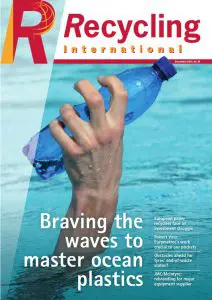Page 33 from: December 2014

33December 2014
Proposal calls for equivalent
WEEE treatment conditions
The third meeting of the BIR’s E-Scrap Committee was
held at the world recycling organisation’s recent con-
vention in Paris. Delegates heard not only about latest
developments involving legislation and standards, but
also about the relentless march of e-scrap generation
on a global scale.
A proposal has been put forward for a delegated regulation on
equivalent conditions for treatment
outside the EU of waste electrical and
electronic equipment (WEEE), it was
confirmed at the BIR E-Scrap Commit-
tee meeting in Paris by Maria Banti,
WEEE policy officer at the European
Commission’s DG Environment Waste
Management & Recycling Unit.
The EU’s new WEEE Directive incorpo-
rates two-step collection targets for
2016 and for 2019 – the former being
45% of new equipment put on the
market in the previous three years, and
the latter 65% of new equipment put
on the market in the previous three
years or 85% of all forms of WEEE gen-
erated. But in order to count towards
these targets, it was proposed that
treatment beyond the EU’s borders
would have to take place in facilities
offering the equivalent of what was
available within the EU. Furthermore,
Banti explained, there would be a need
to prove that the treatment conditions
were indeed equivalent.
Steep upward curve
The exponential growth in electronics
– and therefore in the volumes of WEEE
generated down the line – was detailed
by BIR E-Scrap Committee chairman
Thomas Papageorgiou of Greece-based
Anamet Recycling Industry. As recently
as two decades ago, a total of 19.5 mil-
lion tonnes of electrical and electronic
equipment was being put on the market
worldwide, with the USA and Europe
representing the dominant players
while China accounted for just 700 000
tonnes. However, the global figure was
expected to soar beyond 76 million
tonnes next year, with China antici-
pated to reach 14.6 million tonnes and
India 5.5 million tonnes. The amount of
waste electronic equipment arising in
Africa was also on a steep upward
curve, the speaker emphasised.
An estimated 53.3 million tonnes of
e-scrap was being generated around the
world every year, comprising approxi-
mately 60% metals (equivalent to some
32 million tonnes), 15% plastics and
12% CRT/LCD screens, Papageorgiou
added. Furthermore, the precious metals
available for recovery from printed cir-
cuit boards were ‘very significant’ for a
number of high-margin applications.
EuRIC to be ‘the voice’
The meeting in Paris also provided an
opportunity for Emmanuel Katrakis to
introduce the newly-formed European
Recycling Industries’ Confederation
(EuRIC), of which he is the first secretary
general. The organisation has been
formed to be ‘the voice’ of the European
recycling industries in Brussels. In the first
instance, it is providing an umbrella for
the European Ferrous Recovery and
Recycling Federation (EFR), the European
Metal Trade and Recycling Federation
(Eurometrec) and the European Recov-
ered Paper Association (ERPA), although
the speaker stressed to delegates that
EuRIC ‘will continue to develop’.
Katrakis then focused on the elabora-
tion of WEEE standards through CENEL-
EC, the European Committee for Elec-
trotechnical Standardization. New work
items proposed for CENELEC included
a ‘specification for the end-processing
of WEEE fractions (copper and precious
metals)’ which, it was said, should be
of concern to any sellers of copper
scrap and of printed circuit boards.
When compared to manufacturers, the
recycling sector was relatively under-
represented on national standardisation
committees, according to Katrakis. This
was ‘a source of concern’ that needed
to be addressed as recyclers were
regularly outvoted both at national and
CENELEC levels.
Lack of understanding
In providing an update on the different
rules imposed by the United Nations,
OECD member countries and the EU
with regard to transboundary move-
ments of e-scrap, the BIR’s environ-
mental & technical director Ross Bart-
ley highlighted problems regarding the
distinction between waste and non-
waste in this context.
When the OECD harmonised its system
with the United Nations, the former
intentionally replaced the latter’s wider
listing with much narrower listings with
regard to e-waste materials and com-
ponents. Special rules applied whereby
unlisted wastes were to be controlled
through prior written notification and
consent, Bartley explained. And as tes-
tament to a widespread lack of under-
standing of these complex existing
laws, the world recycling organisation
continued to receive numerous inqui-
ries on this subject, he also noted to
delegates in Paris.
As for transboundary movement of a
used good for reuse, there needed to
be sufficient certainty that it would
actually be reused because, if not, its
incorrect disposal might pose a threat
to human health and the environment,
according to Bartley.
By Ian Martin E – S C R A P
RI-10 BIR e-scrap.indd 33 04-12-14 14:28



